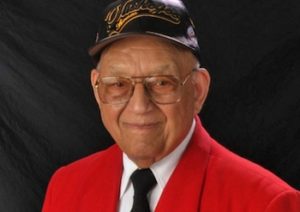
Robert Friend
*Robert Friend was born on this date in 1920. He was a Black military officer and Tuskegee Airman.
Born in Columbia, South Carolina, Friend was interested in aviation from a young age. He read stories of World War I pilots in old magazines and made his makeshift airplanes for imaginative play. Friend had wanted to enlist in the Army to fly for our country but was turned away. Even though the country was making preparations for war, black Americans could not join the Armed Forces to serve as pilots.
While a student at Lincoln University in Pennsylvania, he took aviation-related courses. When the Civilian Pilot Training Program began in 1939 for college students, Friend eagerly applied and was accepted. He completed the program and earned his private pilot’s license. But this was only the first step to becoming a military pilot. When the program opened an opportunity for a segregated pilot training program at Tuskegee, Friend finally had his chance to join the war effort and earn his wings for his country. After completing all training phases, he was commissioned as an U.S. Army Air Corps officer and assigned to the 301st Fighter Squadron of the 332nd Fighter Group.
By that time, the country had officially entered the war. When deployed overseas, Friend was first sent to North Africa, then to the European Theater as a Combat Operations Officer at the squadron and group levels. He was responsible for planning and organizing strategic and tactical air mission implementation. Friend was a skilled pilot in the P-47 and P-51 aircraft. He flew wingman for Benjamin O. Davis Jr., who would later become the first black general of the United States Air Force. He flew 142 combat missions in World War II. His service extended in several other capacities during the Korean and Vietnam wars. He finished his education at the Air Force Institution of Technology.
His career with the Air Force included serving as Assistant Deputy of Launch Vehicles, working on important space launch vehicles such as the Titan, Atlas, Delta rockets, and the Space Shuttle. He served as a Foreign Technology Program Director, where he identified and monitored research and development programs related to national security. He was also the Director of the Unidentified Aerial Phenomena Program, tasked with investigating unidentified flying objects. When Friend was in the air during World War II, he flew a P-51D Mustang. It’s almost certain that the P-51D Friend piloted himself and never returned to the States. When the war ended, it was too much trouble to return many of the combat aircraft to the U.S., and they were commonly scrapped in Europe, or if they were returned to the states, they were sold to civilians for very little.
After retiring from the military, his expertise was utilized to oversee the design and production of space products for the Space Shuttle program, lead a company that creates components for the International Space Station and other satellite systems, and direct the research and development for USAF weapons and missile programs. He lived his retired life in Irvine, California. He was married to Doris “Bunny” Hall and Kathryn Ann Dorsey before marrying Anna (maiden name), to whom he was married for 51 years when she died in 2010.
Lt. Col. Robert Friend died on June 21, 2019; he is survived by children Thelma Hoffman, Robert J. Friend, Jr., Michael D. Friend, Debra D. Carter, Dana A. Friend, Clara Ann Browning, and Karen E. Crumlich. His son, Darry R. Friend, died in 2002 while on active duty. He is also survived by 19 grandchildren, 31 great-grandchildren, and 19 great-great-grandchildren. Lt. Col. Friend was a master bridge player, well-known and respected nationally, and competed in national tournaments in his spare time. At the time of his death, he was one of 12 surviving Red Tail Pilots.